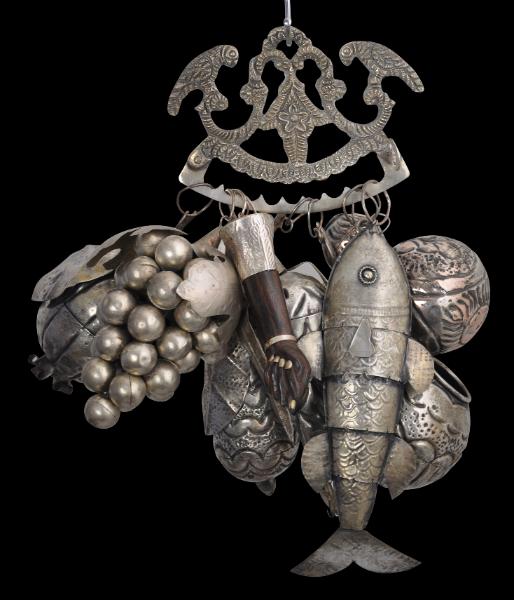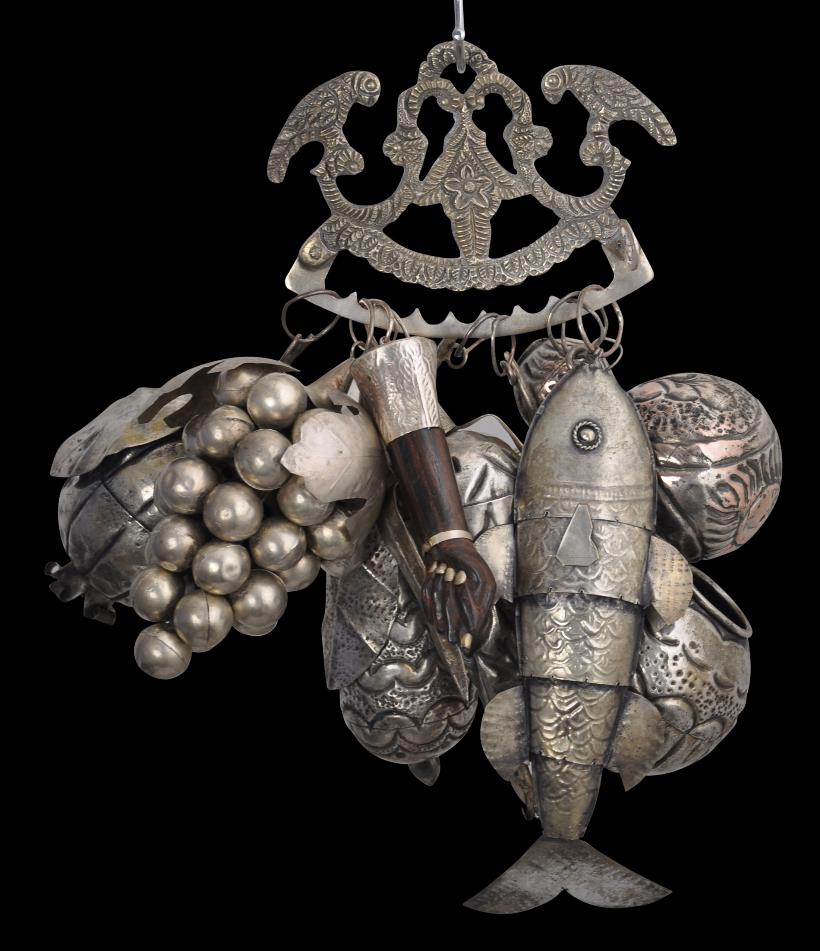
Brazilian Balanganda
Silver & Copper Balanganda
Brazil, probably Bahia
19th century
height: 29cm (approx.), width: 22cm (approx.), weight: 763g
This large balanganda votive set comprises a ring-like structure cast in silvered base metal and decorated with cast perched birds from which ten talismanic items, mostly made of silvered hollow sheet copper and silver alloy, but including one item in the shape of a hand and forearm in dark wood with silver mounts, are suspended.
Among the suspended charms is a reticulated fish (which is unusual), a bunch of plump grapes, and an orange.
The wooden forearm has a fist clenched with the thumb extended between the index and middle fingers – a fertility symbol – although Stratton-Pruitt (2013, p. 184) offers another interpretation in that evil creatures were believed to be asexual and frightened by allusions to sexuality and so were warded off by an amulet that could also be seen as sexually suggestive and obscene. The nails, wrist band and upper section of the fist and forearm are encased in silver.
Balangada have the most extraordinarily evocative histories: they were worn at the waist by black and mulatto women, often indentured, mostly in the Brazilian coastal state of Bahia, during the nineteenth and early twentieth centuries as amulets. They were worn suspended from a heavy chain that went around the waist, often accompanied by thick silver bracelets, a multitude of heavy silver rings and necklaces. Typically, such sets were added to as their owners could afford to buy more items. Balangada were made by black silversmiths and illustrate the coexistence of African superstitions with Christian beliefs in Brazil.
Several balanganda are illustrated in Taullard (2004). Another set, illustrated in Stratton-Pruitt (2013, p. 84), includes a carved wooden clenched fist, similar to the example here.
Such sets occasionally turn up in England, often around Liverpool. Interestingly, Liverpool was the main seaport in the 18th and 19th century which was at the heart of the so-called ‘triangle’ trade whereby merchant ships transported slaves from Africa to Brazil (typically calling in at Bahia from where balanganda sets are believed to originate), and then sugar from Bahia to Liverpool, and from Liverpool, manufactured items to Africa. It is likely that English sailors souvenired the balanganda sets from Bahia and brought them home to Liverpool as gifts for family members.
The set here is in fine condition.
References
Stratton-Pruitt, S.L., Journeys to New Worlds: Spanish and Portuguese Colonial Art in the Roberta and Richard Huber Collection, Philadelphia Museum of Art/Yale University Press, 2013.
Taullard, A., Plateria Sudamericana, Ediciones Espuela de Plata, 2004.
Provenance:
UK antique market
Inventory no.: 3365
SOLD



A late 19th century photograph of a Brazilian woman wearing a silver balanganda at her waist.


